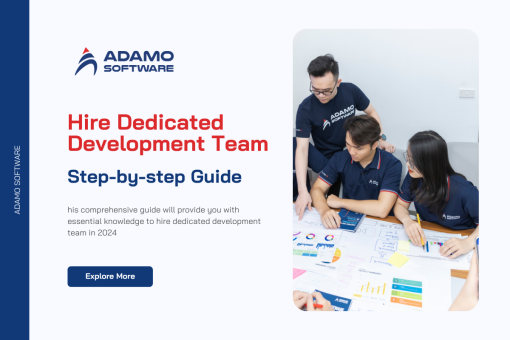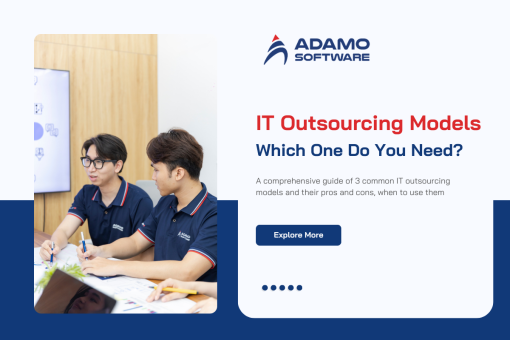IT Staff Augmentation: Types, Pros & Cons, Process and Top Destination
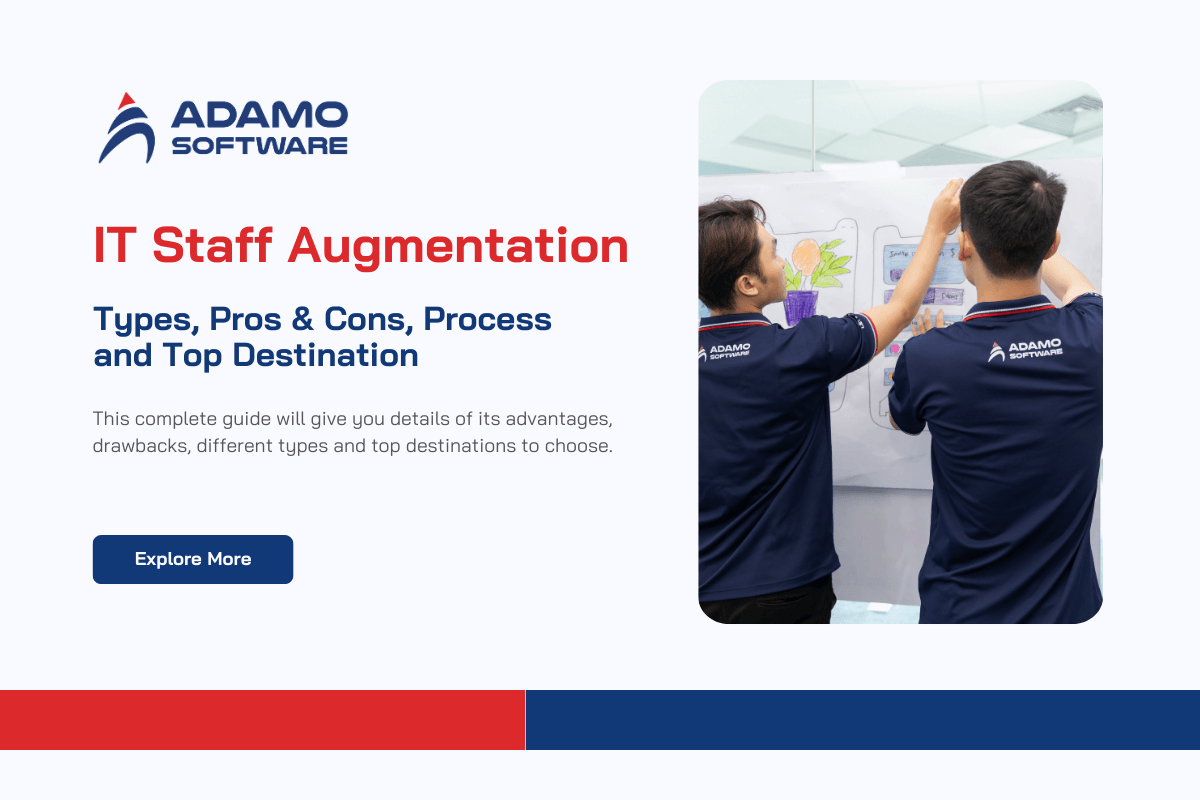
Explore how IT staff augmentation services help your software project. This complete guide will give you details of its advantages, drawbacks, different types and top destinations to choose.
In today’s digital world, the demand for IT professionals is soaring high. Statista predicts that the global IT industry will make a revenue of US $1,570.00 billion by 2027.
However, there’s a big problem slowing down this growth – the shortage of skilled IT professionals. There are plenty of job openings in IT, but there just aren’t enough qualified candidates to fill them. By 2030, it’s estimated that the skills gap and talent shortage in the U.S. alone will result in a loss of $8.5 trillion, according to research by PwC.
This is why businesses are struggling to find the right people for their tech roles. Many are avoiding hiring full-time staff and are turning to alternatives like IT staff augmentation services. The US IT staffing market is expected to hit around $39 billion by 2024.
If you’re thinking about getting outside help to boost your tech capabilities, this blog is for you. We’ll explore what staff augmentation is in the IT field, how it operates, its advantages, and even its drawbacks, as well as different types and models.
I. What is IT Staff Augmentation
IT Staff augmentation is a flexible talent management approach that allows businesses to supplement their existing workforce with external experts on a temporary or project basis. This strategy involves hiring skilled professionals from outside the company to address specific project requirements or fill skill gaps.
Unlike traditional hiring models, which are more long-term and static, IT staff augmentation provides immediate and dynamic solutions to meet immediate needs. It is not about replacing the existing workforce but rather complementing and enhancing it.
Picture this: you have a project to build a Travel Portal System that requires a team of five developers. But your current in-house IT team only has three members, that means you have a gap of two to three months before you can assemble the full team. Now, you can think about IT staff augmentation service to avoid spending months on recruitment, contracts, and finding the right fit for your team. When the project is done, you won’t have to deal with legal issues if you no longer need their services.
Specialized staff augmentation firms can quickly provide you with dedicated IT professionals who are ready to join your project. These professionals are employed and managed by the third-party partner, which means a faster onboarding process and no need to handle payroll, office administration, vacations, training, or other administrative and legal tasks.
II. Benefits of IT Staff Augmentation
A survey conducted in 2023 has pointed out that 77% of global employers find it tough to attract the skilled talent they need, with 78% of these employers in the IT industry. This is why more companies are turning to staff augmentation to meet their time and budget constraints. If you already have a development team with a project manager, hiring contractors is often better than bringing on a full, dedicated software development team from a vendor. Here are key benefits of IT staff augmentation:
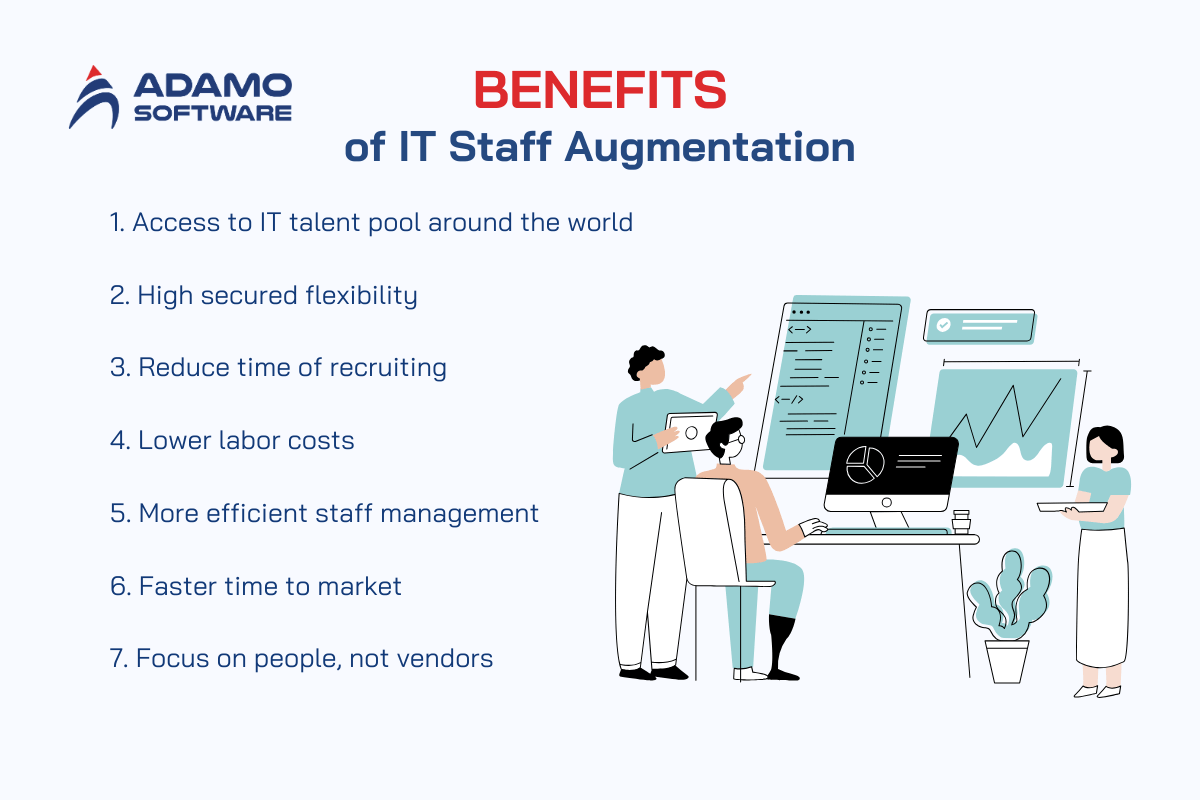
1. Access to IT talent pool around the world
Adding external professionals to your IT team helps you tap into a pool of highly skilled and experienced talent that might not be available locally. This means you get the right people with the right expertise for your projects.
2. High secured flexibility
IT staff augmentation offers flexibility while being backed by a talent-sourcing vendor. It’s perfect for handling large, upcoming projects or unexpected workloads. This model lets you quickly add people with the necessary skills, enabling you to take on projects of any size and complexity. You can also fill vacant positions in just a few days.
3. Reduce time of recruiting
Recruiting can be a long and uncertain process. What if you spend months hiring someone only for them to leave shortly after? Or what if you need to hire someone quickly but can’t find the right fit locally? IT staff augmentation is a faster solution. Vendors with extensive databases of vetted specialists can match you with the right talent quickly, saving you time and effort.
4. Lower labor costs
On-demand IT staff augmentation saves money on setting up workspaces, providing equipment, and covering benefits like vacations, sick leave, and health insurance. While top-quality talent might still command high salaries, this approach is generally more cost-effective than in-house hiring. It’s wise to hire good candidates quickly, as the demand for professionals is high, and you might lose them to other companies.
5. More efficient staff management
With IT staff augmentation, you have more control over your team and workflow compared to project-based outsourcing. You can also address issues promptly, rather than waiting for an outsourced manager to inform you of a problem months later.
6. Faster time to market
If you use staff augmentation, you can quickly scale your teams up or down, speeding up project timelines and getting products or services to market faster.
7. Focus on people, not vendors
When looking for an IT outsourcing vendor, many business owners often focus on the vendor’s experience and expertise. But these factors don’t always guarantee high-quality work. A better strategy is to identify the skills you need for your project first.
With IT staff augmentation, you can hire the exact experts you need, regardless of the vendor. You can select programmers from different firms or find a vendor that offers all the specialists you require. Either way, you can onboard the necessary software developers in about a week.
III. 3 Types of IT Staff Augmentation
IT staff augmentation helps businesses quickly expand their teams and access specialized talent for a short time. To choose the right service, it’s important to understand the different types available:
1. On-site staff augmentation
On-site IT staff augmentation involves bringing temporary professionals to work directly at your location. It’s perfect for projects needing close coordination, team alignment, and face-to-face interaction as it allows for direct collaboration and easy integration into your existing teams.
2. Remote IT staff augmentation
Remote staff augmentation involves hiring professionals who work from different locations. This type gives businesses access to a global talent pool, ideal for specialized skills or cost-effective solutions. It also offers flexibility, scalability, and the ability to work across different time zones. However, effective communication and project management are required to ensure successful collaboration.
3. Project-based IT staff augmentation
Project-based staff augmentation brings in experts for specific projects or assignments. Businesses can utilize specialized skills and knowledge without long-term commitments. It’s great for short-term projects or when you need specific expertise not available in-house.
Also read: Onshore, Nearshore, Offshore Outsourcing – How to Choose 2024
IV. IT Staff Augmentation vs Other Models
As mentioned earlier, IT staff augmentation involves outsourcing the talent you need. But it’s just one of many options available for outsourcing. There are several other models to consider, such as dedicated development team, independent contractors (freelancers), and managed services. So, how do these compare to staff augmentation, and which one is right for you?
1. Staff augmentation vs dedicated development team
A dedicated development team offers companies a specific group of skilled professionals tailored to their project needs. This team typically includes software engineers, UI/UX designers, QA professionals, project managers, and business analysts. Similar to staff augmentation, hiring a dedicated team means you don’t have to worry about retirement contributions, taxes, HR expenses, or medical benefits.
However, the main difference between hiring a dedicated team and staff augmentation is the level of control. With a dedicated team, the vendor primarily manages the team after defining the scope, selecting talent, and holding kick-off calls. In contrast, with staff augmentation, you have direct control and collaboration with the augmented contractors, like managing your in-house staff.
Also read: Hire Dedicated Development Team: Step-by-step Guide 2024
2. Staff augmentation vs independent contractor (Freelancers)
When you hire independent contractors, managing them is similar to staff augmentation or dedicated team models. If you hire a freelancer through a platform, you’ll need to pay a commission. However, hiring a freelancer directly means you’re free from commission fees and have less paperwork.
Hiring an independent contractor carries more risks. For instance, you can’t guarantee that the freelancer won’t find a better deal and leave your project halfway, whereas the staff augmentation model minimizes this risk.
3. Staff augmentation vs managed services
Managed services have become increasingly popular and are expected to grow to USD $354.8 billion by 2026. The managed service model allows you to focus on your core business instead of dealing with IT service issues. The difference between staff augmentation, managed services, and project outsourcing lies in the level of client control. In managed services, the software development supplier manages the delivery model, processes, and tools. In contrast, staff augmentation gives the client the most control.
This model, besides, may be beneficial if you need to outsource the support of your day-to-day operations, such as software updates, operating SaaS or PaaS. It serves as an all-in-one solution, monitoring critical functions and providing repairs. Staff augmentation focuses on outsourcing tasks and operations, while managed services focus on IT solutions and management.
Also read: IT Outsourcing Models – Which One Do You Need
V. IT Staff Augmentation Process Flow: 5 Steps
Augmenting an IT or software team might be a great way for companies that need to strengthen their current IT staff. These guidelines will help you guarantee both a fruitful collaboration and top-notch IT solutions.

Step 1: Identify the requirements
Start by identifying why you need extra help. This might be due to a lack of skills, missing expertise in a certain area, or an upcoming project that requires more resources.
Step 2: Determine the scope of work
Next, figure out the scope of the project. Decide on the roles and responsibilities of the external IT staff, the length of the engagement, and the specific skills and expertise needed.
Step 3: Choose the right vendor
Find suitable candidates through referrals, recruitment agencies, or job postings. Make sure to thoroughly screen and interview them to ensure they have the necessary skills and experience.
Step 4: Onboard and integrate
Once you’ve selected the candidates, onboard and integrate them into your existing IT team. Provide them with access to necessary systems, tools, and resources, and introduce them to the team.
Step 5: Onsite management
Throughout the engagement, manage and oversee the external IT professionals. Regularly check in and provide feedback to ensure they meet expectations and deliver on project requirements.
VI. When You Should Choose IT Staff Augmentation Services
A report by CompTIA’s Workforce and Learning Trends Report has shown that 40% of businesses hired new staff during the pandemic, and 66% plan to continue doing so.
IT staff augmentation services are a good fit if you:
_ Want to support your in-house team
IT staff augmentation helps expand your existing team by adding more people who can handle your workflow tasks or fill specific expertise gaps, such as PHP, Java, automated QA, backend development, blockchain, or AI services.
_ Already have a tech-savvy manager
Using IT staff augmentation means you manage the team on your side. You stay in charge of product development and team management, so it’s very important to have a good manager with technical knowledge. Usually, the augmented staff reports to your company’s CTO or project manager.
_ Need high skilled staff
IT Staff augmentation is ideal when you need experienced software engineers. These projects rarely involve junior developers since there’s no time or resources for training. Experienced engineers can quickly adapt to a project and working environment.
_ Require better team communication
If you want full control over your project and prefer to know every team member, IT staff augmentation is a great option. The augmented team members will work closely with your in-house team and report directly to you on a regular basis.
VII. Drawbacks of IT Staff Augmentation to Consider
While the IT staff augmentation model can be a good way to save money and improve efficiency, it’s important to be aware of the challenges involved.
Let’s discuss some of the main challenges that you may face when it comes to IT staff augmentation:
1. Poor quality control
Sometimes, managers prioritize cost reductions over other important criteria and end up hiring poor developers. This can lead to expense overruns, project delays, and security risks for end users. To avoid this, establish stringent quality control measures and ensure that your augmented staff is well-trained.
2. Privacy risks
When you outsource work and involve a third party in your internal operations, trust becomes vital. To address any security hazards or threats, try to conduct regular security audits and have a robust non-disclosure agreement signed by the augmented staff to ensure data protection and security
3. Managerial bottlenecks
Since IT staff augmentation involves outsourcing, the staff you hire may not be operating in your office. Remember to establish efficient management and communication channels to keep your augmented and in-house staff in sync during project completion
VIII. How to Choose the Best IT Staff Augmentation Companies
While IT staff augmentation is often seen as a short-term solution, choosing the right vendor has long-term effects on your business’s success and productivity.
Here’s a simple guide to help you find the right IT staff augmentation partner:
Step 1: Understand your project and staffing needs
Before you start looking for a staffing partner, get a clear picture of your project requirements and where your in-house team might need help. Ask yourself these questions:
_ How much can you afford to spend on staff augmentation?
_ How long will the project last?
_ Do you need a dedicated team or just a few extra hands?
_ What specific skills are you missing in your current team?
_ Will you need these skills short-term or for the whole project?
_ What are your company’s essential values that any partner should respect?
These questions will help you define your needs and communicate them clearly to potential staffing partners.
Step 2: Evaluate potential partners thoroughly
Once you know what you need, it’s time to find a suitable staffing partner. Here’s how to do it:
_ Check their expertise and tech stack: Make sure the staffing agency has experience in your industry and is familiar with the technology you use.
_ Review their portfolio and case studies: Look at the projects they’ve completed. A good agency will have a portfolio on their website showcasing their past work and success stories. If not, ask them to provide case studies.
_ Get client references: Ask for references from their previous clients. Speak with these clients to get an honest review of the agency’s performance and service quality.
Step 3: Conduct group interviews
If you’re hiring multiple contractors from the same outsourcing firm, consider doing a group interview. This helps you see how well they work together and fit into your team. Here are some tips for group interviews:
_ Plan questions: Focus on the specific role and technologies involved.
_ Assess soft skills: Evaluate how well they communicate and collaborate.
To make these interviews effective, prepare your questions ahead of time. Tailor each question to the roles and technologies needed for your project to ensure the candidates can meet your standards.
Step 4: Carefully negotiate contract details
Now you turn to finalize the contract. This stage requires attention to detail since many firms use standard contracts that may not cover all your project specifics.
Ensure your contract includes:
_ Clear project timelines with deadlines and milestones.
_ Agreed-upon payment terms.
_ How you will provide and receive feedback.
_ Protection and ownership of your intellectual property.
_ Standards for measuring success.
Choose a partner willing to customize their contract to fit your project’s unique needs. If the provider is flexible and aligns with your goals, it’s a good sign. If not, you might want to look for another provider to avoid potential legal issues and additional costs.
Step 5: Select the right partner
The goal of IT staff augmentation is to enhance your internal team with external talent. Only choose verified talent from augmentation firms that have passed your screening process. After following the previous steps, you should feel confident that your chosen provider can add value and share your project vision.
IX. Top Destinations for IT Staff Augmentation
1. Asia
With 59% of the market share for IT outsourcing, Asia is a key player in the IT staff augmentation market, known for its vast pool of skilled workers and affordable rates.
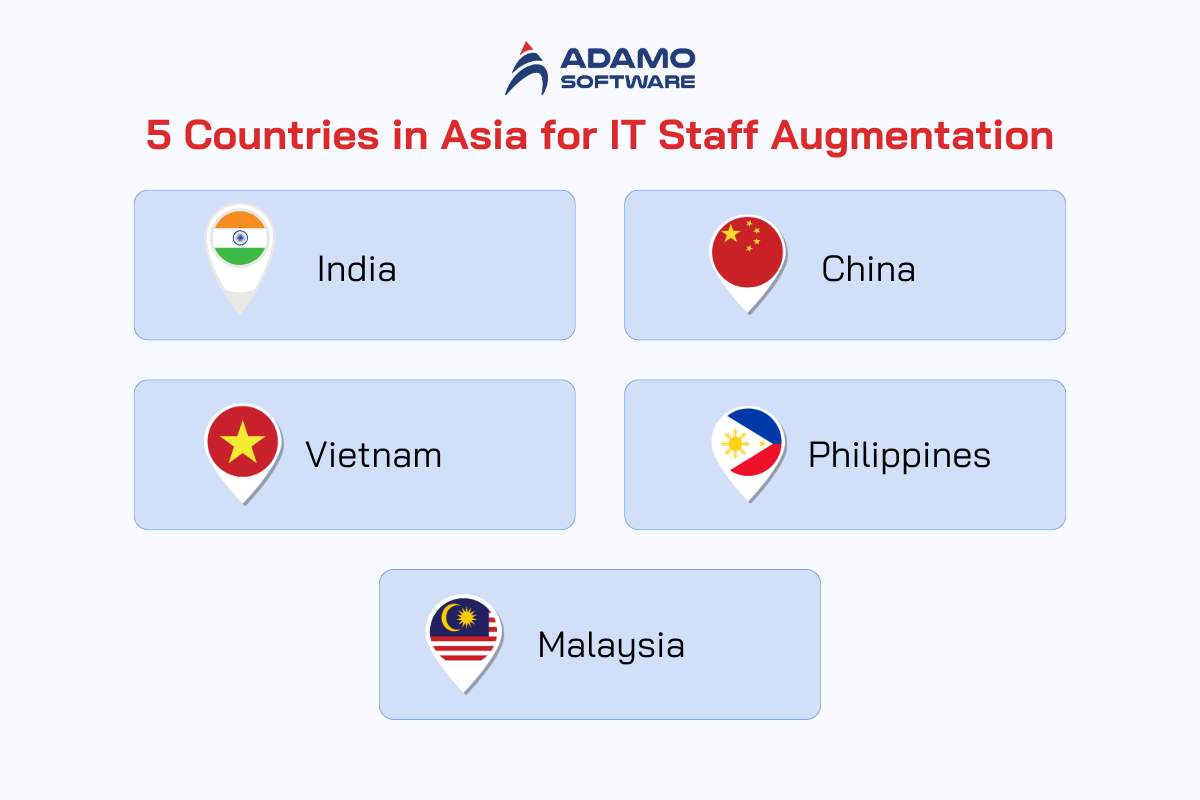
_ Range of skills: Asia has a wide variety of highly skilled IT professionals. For instance, Vietnam is famous for its software development and IT services, with expertise in Java, Python, PHP, mobile development, and artificial intelligence. Countries like China, Vietnam, and Malaysia are also becoming key players, offering skills in software engineering, data analysis, and cybersecurity.
_ Time zone: Time zone differences can be tricky when working with Asian teams. But this can be managed by having flexible working hours and overlapping shifts to ensure good communication. For businesses in the USA, there is often a significant time difference, but for companies in Australia and the Asia-Pacific region, the overlap is more manageable.
_ Pricing: One of the biggest pros of outsourcing to Asia is the cost. Rates vary across the region but generally range from $15 to $50 per hour, depending on the country and the complexity of the work.
Also read: Top 12 IT Outsourcing Companies in Vietnam – 2024 Reviews
2. Central and Eastern Europe (CEE)
CEE is also a great region for IT staff augmentation. North American companies, in particular, benefit from the strong IT potential in countries like Poland, Ukraine.
_ Range of skills: This region has highly skilled developers who are experts in many programming languages, including JavaScript, Java, PHP, Python, Ruby, Android, iOS, and AI/ML. CEE is also known for talent in fields like Finance/Banking, Healthcare, Security, Gaming, and Automotive.
_ Time zone: The CEE time zone is great for real-time collaboration, especially with companies in Western Europe and the UK. This ensures smooth cooperation between remote and internal team members. Even for companies further away, there are usually a few hours of overlapping work time.
_ Pricing: The cost of IT outsourcing in CEE ranges from $21 to $118 per hour, not including vendor fees. Countries like Ukraine, Moldova, Romania, and Bulgaria are more affordable, while the Czech Republic, Hungary, and Poland tend to be more expensive due to higher living costs.
3. Latin America (LATAM)
Revenue of the IT outsourcing market in LATAM is predicted to reach $17.98bn in 2024. LATAM has become a popular region for IT outsourcing, especially since the COVID-19 pandemic. Top destinations include Brazil, Argentina, and Mexico, with about one million IT experts.
_ Range of skills: The IT market in LATAM is booming, supported by a strong tech sector, a vibrant startup culture, and new tech education programs. Countries like Brazil, Argentina, and Mexico rank high in tech and innovation skills. Developers in these countries excel in programming, mobile development, and cloud computing.
_ Time zone: For companies in the USA, LATAM offers excellent time zone alignment. Mexico shares the same time zone as the USA, providing up to 8 hours of overlapping work time. Brazil and Argentina, in the EST time zone, offer up to 7-5 hours of shared work hours, making real-time collaboration easier.
_ Pricing: The hourly rates for IT outsourcing in LATAM range from $28 to $105 per hour, not including vendor fees. Brazil has higher rates compared to Mexico and Argentina, but LATAM is still a cost-effective option for many businesses looking to outsource IT services.
X. How IT Staff Augmentation Works at Adamo Software
Adamo Software is a premier software outsourcing company in Vietnam, offering services like mobile app development, web development, AI, and blockchain. We frequently receive IT staff augmentation requests and have built solid expertise in this area. Here’s how our staff augmentation process works:
_ Initial contact: Clients reach out to us to expand their in-house team. Our team then review the requests and schedule a call with the client to discuss details like the required qualifications and the IT staff augmentation contract.
_ Choosing developers: Once we understand the client’s needs, we select specialists with the right skills (back-end developers, front-end developers, QA engineer, UX/UI designers…). We send their CVs to the client for review.
_ Interview: After the client approves the CVs, the selected IT specialists undergo an interview to assess their skills. Sometimes, this involves two stages: an interview with our CTO and then with the product owners or project managers.
_ Signing a contract: If everything goes well, we sign a contract and bring the selected developers onto the project.
Our specialists have strong communication and English skills. They are typically middle or senior-level engineers, or team leaders if needed to oversee the team’s work.
If you want to delve more into our IT staff augmentation process, don’t hesitate to reach out to us. We’re ready to help.









